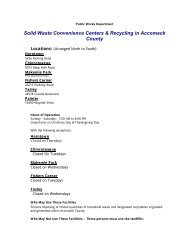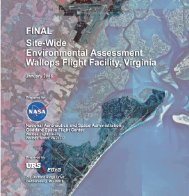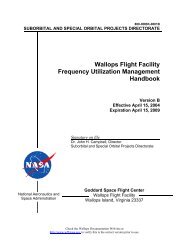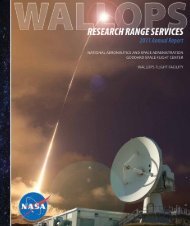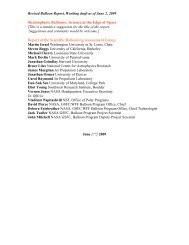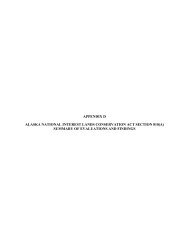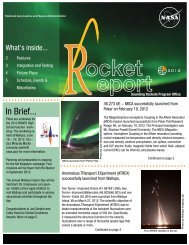Alternative Energy Draft EA - NASA Visitor Center at Wallops Flight ...
Alternative Energy Draft EA - NASA Visitor Center at Wallops Flight ...
Alternative Energy Draft EA - NASA Visitor Center at Wallops Flight ...
Create successful ePaper yourself
Turn your PDF publications into a flip-book with our unique Google optimized e-Paper software.
Environmental Consequences<br />
Piping Plover nesting announcement; this annual message is sent to all WFF employees,<br />
informing them of the potential for encountering the protected species.<br />
Although suitable habit<strong>at</strong> would not be affected by the project, avian mortality has been<br />
documented as an adverse effect of birds colliding with the rot<strong>at</strong>ing blades of wind turbines and<br />
cannot be discounted. As such, the Proposed Action may affect, and is likely to adversely affect,<br />
the Piping Plover.<br />
Wilson’s Plover<br />
The utility-scale wind turbines and access roads would be constructed on the opposite side of the<br />
island from the preferred habit<strong>at</strong> of Wilson’s Plover, presenting a reduced risk of avian mortality<br />
associ<strong>at</strong>ed with wind turbine collision. No construction is planned for areas within potential<br />
nesting habit<strong>at</strong>s or areas of the beach and lagoon environments within which the species typically<br />
would stopover, nest, and/or feed. Noise from the construction activities would be of short<br />
dur<strong>at</strong>ion and would likely present minor, if any, startle reactions. The Proposed Action may<br />
result in minor adverse impacts on the Wilson’s Plover.<br />
Red Knot<br />
All construction activities would be loc<strong>at</strong>ed outside of the beach and lagoon environments within<br />
which the species typically would stopover and/or feed. Red Knots would be expected to be<br />
present in areas suitable for Piping Plover nesting during similar times of year. As such, <strong>NASA</strong><br />
would continue to coordin<strong>at</strong>e with CNWR and USDA staff during their monitoring efforts along<br />
the <strong>Wallops</strong> Island beach. Additionally, educ<strong>at</strong>ional signs would be posted <strong>at</strong> all beach access<br />
points to raise awareness of the species. Basic species identific<strong>at</strong>ion will be included in the<br />
n<strong>at</strong>ural resources training module of the WFF EMS, a requirement for all new employees <strong>at</strong> the<br />
facility. WFF would add the Red Knot to its annual Piping Plover nesting announcement; this<br />
annual message is sent to all WFF employees informing them of the potential for encountering<br />
the protected species.<br />
Although the Red Knot has been observed in Accomack County, the Proposed Action would<br />
occur on the opposite side of <strong>Wallops</strong> Island from the Red Knot’s preferred habit<strong>at</strong> of tidal fl<strong>at</strong>s<br />
and sandy or pebbly beaches (i.e., on the sound side). This is where Red Knots have been<br />
historically been observed to occur on <strong>Wallops</strong> Island. However, because Red Knots may also<br />
utilize marsh habit<strong>at</strong> and th<strong>at</strong> potential effects cannot be discounted, the Proposed Action may<br />
affect, and is likely to adversely affect, the Red Knot.<br />
Peregrine Falcon<br />
The utility-scale wind turbines and access roads would be constructed within potentially suitable<br />
habit<strong>at</strong> for the Peregrine Falcon. Avian mortality has been documented as an adverse effect of<br />
birds colliding with the rot<strong>at</strong>ing blades of wind turbines. Nesting habit<strong>at</strong> would not be affected<br />
by the project. To reduce the effects to the Peregrine Falcon resulting from habit<strong>at</strong> disturbance,<br />
<strong>NASA</strong> has proposed the minimum necessary width for the access roads to the utility-scale wind<br />
turbines. Because Peregrine Falcons may utilize marsh habit<strong>at</strong>, the Proposed Action may result<br />
in minor adverse impacts on the Peregrine Falcon.<br />
124




